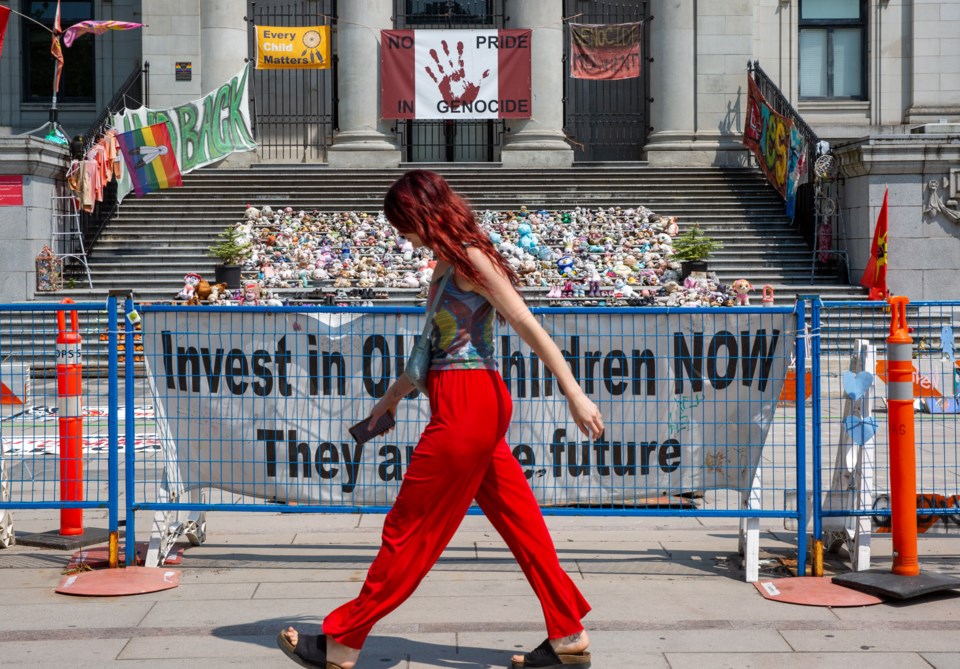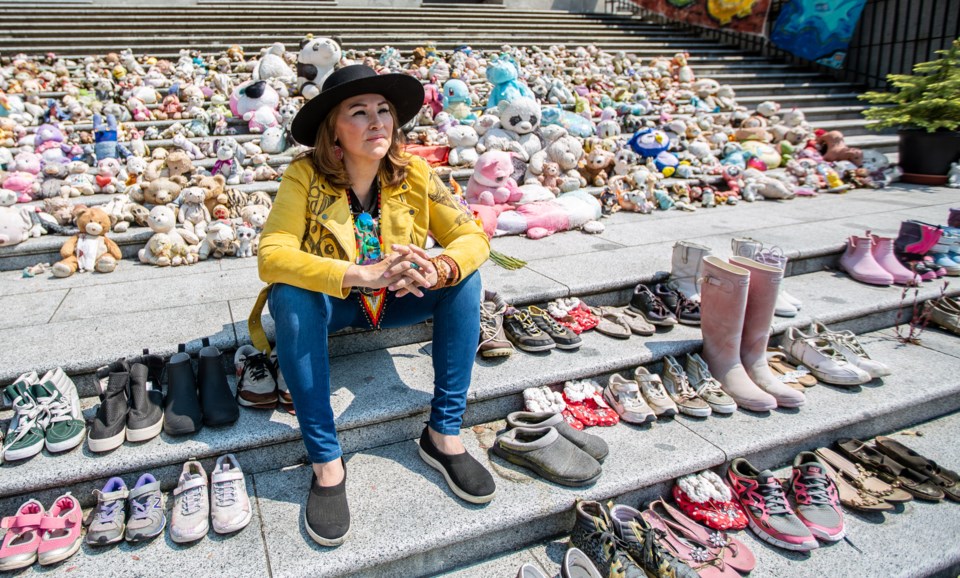Update: The memorial is being dismantled on Friday, May 19. Read more about that HERE.
More questions than answers remained Wednesday about the future of a residential school memorial set up almost two years ago on the steps of the Â鶹´«Ã½Ó³»Art Gallery as city officials continue to call for its removal by the end of the month.
The City of Â鶹´«Ã½Ó³»stated publicly in March and reiterated this week in an email exchange with Glacier Media that the memorial was never meant to be permanent and was installed without consultation of the Musqueam, Squamish and Tsleil-Waututh nations.
“The city should have acted sooner to bring the memorial to a close once it was aware that the local nations were not consulted and had not given formal permission prior to the memorial's installation,” the city said in an email.
Haida artist Tamara Bell set up the memorial in May 2021 in response to the discovery by Tk'emlúps te Secwépemc First Nation of what is believed to be 215 unmarked graves of children who were students at the Kamloops Indian Residential School.
Bell and her son placed 215 pairs of shoes on the southside steps of the art gallery at Robson Square. Bell said this week that she believed the memorial would only last a few hours or days before city crews disposed of the shoes.
“The idea was just to put the shoes down to honour those children, but then shortly after that, people came forward from all over the place,” she said, pointing out the stuffed toy animals and additional shoes placed on the steps.
“It was really just the simplest thing. I never expected it to do anything. I expected it just to be thrown in the garbage an hour later.”
Various signs, including one in the design of the Canadian flag that reads, “No pride in genocide” and another with the slogan, “Every child matters” have been tied to columns at the top of the steps.
The memorial inspired volunteers to keep vigil at the site, which is now protected by a blue metal fence and City of Â鶹´«Ã½Ó³»barriers. A teepee, three other tents, a small fire pit and a portable toilet also fill the space, which has expanded into the pedestrian path at the square.

'Healing park'
Bell visited the site Wednesday but said it is not her decision alone to decide the memorial’s fate. She emphasized the memorial was set up after speaking to Indigenous elders from Musqueam and Tsleil-Waututh.
“I am not an expert on protocols, but the people I go to when I'm seeking guidance are elders,” said Bell, who lives on the Musqueam reserve in southwest Vancouver. “I don't go to the three host nations. I go to elders, and that's who I sought approval from and consultation with.”
The city said it wants the memorial removed in advance of the two-year anniversary of the installation, which falls on May 28. The city said it is “working towards collaboration” with the three nations, Bell and volunteers to bring the memorial to a close in a “culturally appropriate way.”
“More information on the closure of the memorial will be shared with media in the near term,” said the city, which would not confirm Bell’s statement that a “healing park” is proposed for the green space adjacent to the square’s pedestrian walkway.
The city, however, acknowledged there is a need for mourning and healing spaces.
“To date, no decisions have been made by the city or park board regarding the form or the location of such space,” the city said. “The city will ensure that both the artist and the volunteers are invited to participate in these future conversations, anticipated to be led by the local nations.”
'Forcefully and aggressively'
Unconfirmed reports Wednesday from people who frequent the square and operate food carts in the area say a ceremony to mark the removal of the memorial is planned for May 21. Glacier Media made unsuccessful efforts to contact the memorial’s head vigil keeper via telephone and at the site for more detail.
Requests were also emailed Wednesday to all three nations’ communications departments to discuss the memorial’s future but none had provided a response before this story was posted.
Bell said she only attended one meeting with city officials, which she described as “highly abusive.” She said the city was “forcefully and aggressively” pushing the volunteers to abandon the site.
“I was actually in tears most of the meeting,” she said, noting four security guards were present in a room at UBC Robson Square.
That negative experience, she added, was exacerbated by the city’s March 31 public news release of the need for the memorial to be removed. She said the fallout from the release has caused a backlash from the public, with Bell and volunteers targeted by citizens who want the memorial removed.
“The thing that is incredibly sad is that they espouse reconciliation and know I come from a vulnerable community where women are targeted, and they knowingly put me front and centre knowing that I would then receive the weight of anti-Indigenous people,” said Bell, noting volunteers at the site are mainly women and have been victims of verbal abuse.
The city responded to that concern, saying: “The city unconditionally denounces racism and harassment directed towards the artist and volunteers involved with the temporary residential school memorial; racism generally, and anti-Indigenous racism specifically is unacceptable and disgraceful.”
The original intent of the memorial — and the one that continues today — was to give Indigenous and non-Indigenous people a place to mourn, to grieve and reflect on Canada’s dark history of the residential school system, said Bell, whose mother and uncles attended the schools.
The Truth and Reconciliation Commission of Canada estimated more than 6,000 children died at residential schools, although other estimates in Indigenous communities suggest thousands more perished.
Some 150,000 children from across Canada attended the church-run, government-funded schools, which were designed to have Indigenous children assimilate into mainstream Canadian society.
The schools operated from the 1840s to 1996.
The city stressed the continuation of the memorial is not aligned with the spiritual practices and cultural protocols of the Musqueam, Squamish and Tseil-Waututh, who share teachings that memorials of this nature are temporary.
"In xÊ·mÉ™θkÊ·É™yÌ“É™m, Sḵwx̱wú7mesh, and sÉ™lilwÉ™taɬ teachings handed down through generations, as long as the memorial remains, the spirits of the children will remain tethered to the items placed on the steps and cannot move on," the city said.
'Free speech zone'
The memorial’s existence received mixed reaction Wednesday from people at the square.
Derrick Baker, who regularly frequents the square, said the space on the steps has always been recognized as a free speech zone for public protest. But, Baker said, he believes the memorial should have been removed long ago and not allowed to increase in size and encroach on the square.
“People have always come, do their protest and they’re gone in three or four hours — some might stay a day or two, even a couple of weeks and I support that,” Baker said. “I’m all for supporting native issues, but surely when you stay six months, one year, and now two years, you've overstayed your welcome.”
Baker, who described himself as a retired person trying to make a living, said he believes the memorial’s extended existence has likely caused some citizens to no longer support the original purpose of the installation of the 215 pairs of shoes.
“This is a place for everyone, not just a few people,” he said.
'It was quite a disaster'
Gursewak Singh stopped at the memorial to take a photograph. The Â鶹´«Ã½Ó³»resident said each time he passes by the installation, it makes him think about all the children lost and the effect on their families.
Singh said he wanted to take a photograph before the memorial is gone to serve as a memory and reminder of Canada’s residential school system, and how it has negatively affected Indigenous peoples across the country.
“I have to support it because there's so many people who have feelings attached to what happened, especially the ones who lost so much — it was quite a disaster,” he said. “I don’t think [the memorial] should be completely destroyed and maybe moved somewhere else. But the whole community has to be involved in the decision, not just the city.”
For Bell, who emphasized she is not the maintainer of the site — “I'm merely the artist who conceptualized a concept in a time of desperate healing within the country” — she said the end result of whatever happens to the memorial should be the creation of a permanent place to grieve.
“Any people who've experienced long-term genocide, we all struggle with post-traumatic stress and we really, really need a place to go and right now there is no place for us to go but the memorial,” she said.
Note: The federal government has set up the National Indian Residential School Crisis Line, which provides 24-hour support to former residential school students and their families. The toll-free number is 1-866-925-4419.



